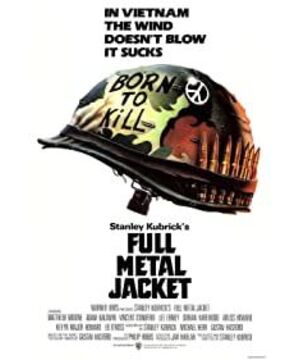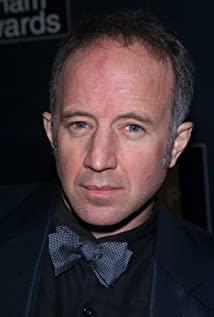This film uses a large number of sports lenses, in addition to the lateral shift, the most notable is the push-pull lens, both as a mechanical motion camera push and pull, and as an optical motion zoom push and pull. It can be said that no matter horizontal shift, push-pull, zoom push-pull, in the middle and late 1980s, as a technical condition, it has long been considered not new. Then let's take a look at how Stanley Kubrick successfully applied these long-suffering sports methods to the film and formed a strong visual style.
At the beginning of the film, a series of short shots were of soldiers getting haircuts, each of them shaved strangely. I think its symbolic meaning is obvious at a glance, and then there is a long follow-up shot: in a huge Marine Corps recruit dormitory, The fierce instructor was pacing on foot, next to rows of bunk beds and recruits standing straight. The camera has been following him smoothly in front, walking three sides of the room before cutting out as the narrative advances.
First of all, the environment of this recruit’s dormitory itself was very depressing. The bunk beds and soldiers were squeezed to the sides. The center was originally very wide, but there were a few huge pillars. Including the colors are both green and pink, it is very weird, reminiscent of the restaurant in "The Shining", due to space limitations, this article will not discuss this in detail. Then, although the camera itself is also moving, the scene, light, and composition relationships within the frame have not changed, deliberately creating a sense of mechanics and dullness, so that the suffocating style tone of the entire film is determined.
In the 7th minute, the camera was drilled in a line on the road to the barracks. The camera followed the marching troops for a long time. Next, the sports shots of the interior and exterior scenes always appear alternately in large numbers. For example, in the 10th minute of the internal scene (dormitory) instructor training remarks, the horizontal shift lens of the training in the 12th minute of the external scene (training field); close to the 13th minute of the internal scene (dormitory) and the pulling lens, the instructor led the entire company of recruits. Walking along his crotch and shouting funny slogans. "My gun", my gun, the gun refers to both the real gun and the stuff in the man's crotch, meaning people who have been tampered with by the war, people who have become strict
Pushing this way of expression to the extreme will form a style. We will find that there is a correspondence between the various means of exercise in the upper half of the film, and each means of exercise itself is strengthened by repeated use of the same environment. For example, the follow-up shots of the instructor in the dormitory were repeated in 32 minutes; the follow-up shots of marching in line on the road of the barracks also appeared twice later, but it was changed from marching to running, and the scene was tighter. , Even the slogans shouted are exactly the same. There is also the performance of the big fat "Fool Bill" gradually going crazy, that is, using the simplest zoom lens. There was a popular argument in the film school for a while, that is to use it with caution or even without zooming, because it is too subjective, too revealing the subjective intentions of the director, and there is no mechanical push and pull in the form, there is a perspective change, and there is a sense of beauty. In fact, there is no difference between good and bad, new and old for any kind of technology. The key depends on how the creator uses it. For example, in this film, in the 30th minute, the first zoom lens for Bill was used to show his psychological change, from the mid-to-close-up shot of the waist. Since the effect cannot be achieved at one time, it is easy to be referred to as The idea is simple, so use it again. In the 32nd minute, Bill was given a close-up shot from the close-up shot to further strengthen the psychological and formal effects. Including the use of a telephoto lens, the first time was a head-on lineup, the second time was a cross-country training, a group of people running on a muddy beach, and the third time was a full-loaded head-on charge. Of course, this is not camera motion and should not be discussed in this article, but it is the same as the motion lenses mentioned above in terms of enhancing the sense of form.
The main function of a large number of panning shots in the film is to show the scene, environment and atmosphere. This was not obvious in the first half, but it was fully utilized in the second half of the Vietnam battlefield. Of course, compared with many other war films, this style is not very distinctive. They are all similar to the background tanks. Some scenes with helicopters hovering and bullets flying across the foreground. The most stylistic feature in the film is the use of a zoom lens. For example, in the 22nd minute, it dissolves from a lens to a row of gun targets, and then a zoom is opened at an amazing distance. First, another company of soldiers trained in gun training appears across the shooting range, and then they continue to pull. Finally, instructors and surroundings appear. Soldiers from the team who listened to him in a circle. According to my rough visual inspection, the distance between the camera and the target is at least one kilometer. It cannot be said that this lens has any special symbolic meaning. It is more like a visual spectacle created by simple technical means. Fortunately, there are one or two lenses with pure formal beauty in the film, which are not only harmless and elegant, but also reflect the zoom. The charm of sports itself can be described as turning decay into magic. Of course, what impressed all the viewers who watched this film most were those zoom lenses that simulated the subjective point of view of a North Vietnamese female sniper. At the 91st minute, a long-distance camera shot the American soldier on the ground from the upper pane. It raised slightly, and an AK47 rifle was drawn from the left side, and then quickly zoomed toward the American soldier. We know that the visual effect of the zoom push is very shocking, but because there is a strong drama factor here, it is very suitable to use. At the 94th minute, the camera once again simulated the subjective point of view of a female sniper and zoomed in sharply. With the sound of the gunshot, another US soldier fell to the ground after being shot. At the 99th minute, the American soldiers hid behind a building. The "cowboy" requested support through the walkie-talkie. The camera was pushed for the third time, and the cowboy's back was clearly revealed through a hole in the building that was blown up. The cowboy fell to the ground, the next shot reversed the cowboy fell to the ground, and there was an instant promotion. As his body slowly fell to avoid the hole, he quickly pushed back to the window where the female sniper was. This set of zoom shots renders the horror and absurdity of the moment of death, making people deeply feel the fragility of life in the battlefield killing.
There is also a wonderful motion shot in the film. The second half is on the battlefield in Vietnam. When the "Joker" went to the front line for an interview, in the 63rd minute, the camera shot the face of the clown from a low angle (close-up shot), and then zoomed out. When it was about to reach the end, the camera began to pull back, revealing that the "Joker" was facing a rectangular burial pit. A row of dead bodies in the pit was covered with lime to prevent decay. It was pale and shocking to the audience. This zoom combined with the mechanical movement of the pull, the process is very smooth, the connection is seamless and perfect. From the sad expression of the "clown" to the cruel scene he saw, the psychological stimulation to the audience was even more intense, thus piercing the anti-war theme of the film like a dagger.
"Full Metal Shell" only won the Oscar for Best Adapted Screenplay, but the film was rated as the "Best Vietnam War Film Ever" by some film critics, and it is not a vain name. Through the analysis of the motion lens in this article, you will feel Stanley Kubrick's profound accomplishments in the image ontology. The audience can go to Lenovo Master Jin Yong's "Dragon Ba Bu", Xiao Feng fought against the heroes of the Central Plains in Juxianzhuang, only a set of martial arts masters practiced Taizu Changquan, and the heroes of the world dare not fight. In this film, we can't see the visual excitement of flying up and down on the screen today. There is no Steadicam or computer special effects, let alone the 360-degree rotation created by the Wachowski brothers with hundreds of digital cameras. However, Stanley Kubrick's use of all the most basic and common exercise methods can be said to be easy to solve, and he played a set of great and powerful Taizu Changquan, which is worthy of being. Master style
View more about Full Metal Jacket reviews











